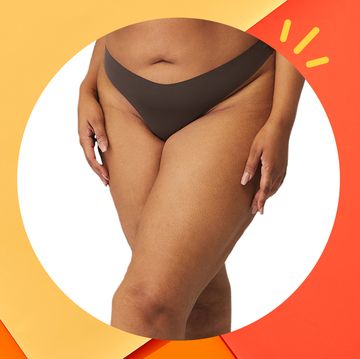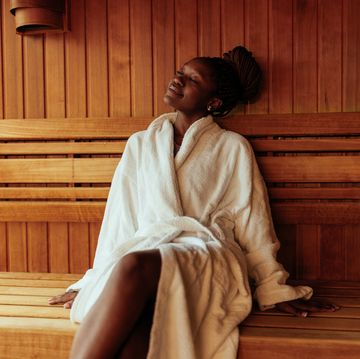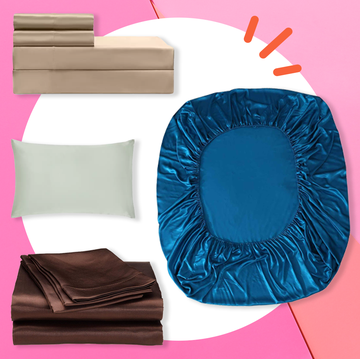Contrary to popular belief, those boney bumps that form on the big toe, known as bunions, aren’t just a problem for grandma and her orthopedic shoes. Almost a third of adults have them, and unfortunately, they can be developed at any age. Here’s what you need to know about this common foot issue.
A bunion is actually the widening of the first two metatarsals (bones) of the foot, says John Mancuso, a doctor of podiatric medicine in New York City. But it’s only a myth that your favorite pair of heels causes them. (Louboutin lovers, rejoice!) They are 100 percent hereditary—thanks, mom.
RELATED: 5 Things That Happen to Your Body When You Stop Wearing Heels
They’re actually quite common, says Rebecca Pruthi, M.D., a podiatric physician and surgeon in New York City. And while they’re hereditary, there are certain factors that up your risk if they do run in your family. According to the American Podiatric Medical Association, those with flat feet, low arches, arthritis, or inflammatory joint disease are most prone to developing them. If you have a job that requires you to be on your feet a lot, you’re also more susceptible to getting bunions, says Pruthi.
While men are just as likely to have a predisposition for bunions as women, a study published in the journal Arthritis Care & Research found that bunions occur more frequently in women. Mancuso says about 85 percent of his patients are female.
That’s where your choice of shoes comes in: While heredity is the underlying cause of bunions, high heels can trigger one since they put more pressure towards the front of the foot, where bunions form, says Pruthi.
Mancuso says exercises that strengthen the arches of your feet (like calf raises) can slow the spreading of the bones in your foot. Making sure you wear the right shoes (roomy ones that have wide and deep toe boxes) can also help minimize your chances of developing one.
Pruthi suggests looking for shoes made from natural material like leather that offer a little give for the most comfortable fit. Bunions can also prove to be particularly bothersome for runners, as they tend to cause serious pronation (an inward rolling of the foot when you walk or run). So you should try arch supports or special kicks that accommodate for pronation. Surgery is the only true fix, though.
RELATED: The 10 Most Repulsive Runners’ Feet Photos You’ll Ever See
“Most people think that bunion surgery just involves taking a hammer and chisel and knocking off the bump,” says Mancuso. “That’s only part of it.” Fixing the underlying cause means narrowing the forefoot where the bones have spread apart. A podiatric surgeon will cut the bone so that they can literally realign the joint and bring the bones closer together.
So when is surgery worth it? It all depends on how bothersome the bunion is. “If it becomes painful, difficult to walk, or difficult to wear shoes, those are the three reasons we consider for surgery,” says Pruthi.
And people are beginning to consider surgery younger and younger, say experts. Mancuso says the bulk of his patients are in their mid-thirties to early forties. “The younger you do it, the less surgery is necessary,” says Mancuso, who explains that the procedure is much easier if it’s performed before the foot has done serious spreading.
RELATED: 5 Things You Should Know Before Having Foot Surgery
Just keep in mind that it is possible for your bunion to come back even after surgery. "Since severities vary with each bunion, there are different surgical procedures to correct the bunion,” says Pruthi. “If the appropriate procedure was performed, reocurrence is unlikely. If it does, it usually takes years and usually is less severe."
--
Macaela MacKenize is a writer, runner, and (aspiring) yogi. Thanks to her inner nerd, she's researched everything from the weirdest health and fitness trends to the behavioral economics of our love lives to what happens when we donate our bodies to science. When she's not writing, you might find her singing in a rock 'n' roll cover band.
Macaela MacKenzie is a journalist who writes about women and power. She covers women’s equality through the lenses of sports, wellness, and the gender gap across industries and is the author of MONEY, POWER, RESPECT: How Women in Sports Are Shaping the Future of Feminism. Mac was most recently a Senior Editor at Glamour where she directed all health and wellness coverage. Her work has appeared in Elle, Glamour, SELF, Bustle, Marie Claire, Allure, Women's Health, and Forbes among other publications.














